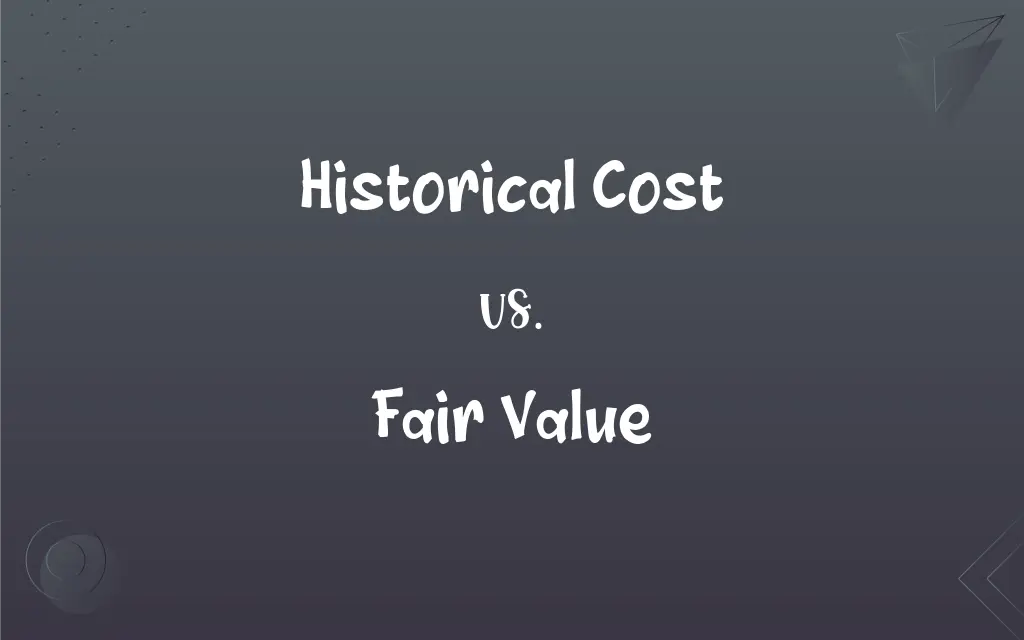Historical Cost vs. Fair Value: What's the Difference?
Edited by Aimie Carlson || By Janet White || Published on January 22, 2024
Historical cost is the original monetary value of an asset, while fair value reflects its current market price.

Key Differences
Historical cost refers to the original acquisition cost of an asset as recorded in the financial statements. It remains unchanged over time, providing consistency in financial reporting. Fair value, in contrast, represents the estimated market value of an asset at a specific point in time, reflecting current market conditions and varying with them.
Historical cost is based on the actual cash or cash equivalent paid during the acquisition of the asset. This valuation method is independent of market fluctuations. Fair value, however, is determined by market conditions, such as demand, utility, and risk factors, making it more dynamic and sensitive to changes in the market.
In accounting, historical cost is widely used under Generally Accepted Accounting Principles (GAAP), ensuring stable and consistent financial statements. Fair value is more aligned with International Financial Reporting Standards (IFRS), offering a more current and realistic view of a company’s financial position.
Under historical cost accounting, assets are not revalued unless impaired. Impairment occurs when the asset’s market value falls below its book value. In contrast, fair value accounting allows for both upward and downward revaluation, offering a more flexible and responsive approach to changes in asset values.
Historical cost is considered reliable due to its objectivity and verifiability. However, it may lack relevance in rapidly changing markets. Fair value, while more relevant in reflecting current market conditions, can introduce volatility and subjectivity in financial reporting, depending on the method of valuation used.
ADVERTISEMENT
Comparison Chart
Definition
Original purchase cost
Current market value
Stability
Unchanged over time
Fluctuates with market
Accounting Basis
Generally based on GAAP
Often aligned with IFRS
Market Sensitivity
Not market-sensitive
Highly sensitive to market changes
Valuation Objectivity
More objective and verifiable
Can be subjective, based on estimates
ADVERTISEMENT
Historical Cost and Fair Value Definitions
Historical Cost
Original cost unaffected by market changes.
Despite market fluctuations, the historical cost of the equipment remains at $10,000.
Fair Value
Used in mark-to-market accounting.
At each fiscal year-end, we adjust our assets to their fair value.
Historical Cost
Basis for asset valuation in traditional accounting.
Our balance sheet lists assets at their historical cost.
Fair Value
Can change with market perceptions.
The fair value of our investments decreased due to economic downturns.
Historical Cost
The purchase price of an asset.
The building's historical cost was $500,000 when acquired in 2000.
Fair Value
Reflects current economic conditions.
The fair value of the property has increased due to the booming real estate market.
Historical Cost
Recorded cost at the time of purchase.
The historical cost in our records for the land is its purchase price from 1985.
Fair Value
Estimated current market price of an asset.
The fair value of our stock portfolio fluctuates daily with the market.
Historical Cost
A measure of past financial investment.
The historical cost reflects how much was originally invested in the machinery.
Fair Value
A dynamic measure of value.
Fair value accounting provides a real-time financial perspective.
FAQs
What is historical cost accounting?
It records assets at their original purchase cost.
How is fair value determined?
Through current market prices and valuation models.
Does historical cost change over time?
No, it remains constant regardless of market changes.
Are all assets measured at fair value in IFRS?
Not all, but many financial assets and liabilities are.
Is fair value more relevant during market volatility?
Yes, as it reflects current market conditions.
Does fair value introduce more risk in financial statements?
Yes, due to its dependence on market fluctuations.
Can fair value be used in GAAP?
Yes, in certain circumstances, such as for financial instruments.
Does historical cost affect a company’s asset valuation?
Yes, it may understate the value in rising markets.
Can historical cost be revalued?
Generally not, except for impairment losses.
Is historical cost subjective or objective?
It's objective, based on verifiable purchase costs.
Is fair value accounting more complex?
Often yes, due to the need for regular revaluation.
How do companies report assets under historical cost?
At their purchase price, minus any depreciation.
How does historical cost affect depreciation?
Depreciation is based on the asset's original cost.
How does historical cost impact financial stability?
It provides stability and consistency in reporting.
Can fair value lead to higher volatility in earnings?
Yes, due to frequent changes in market values.
Can historical cost provide misleading asset values?
Yes, particularly in rapidly changing markets.
Is fair value always market-based?
Primarily, but it can also involve valuation techniques.
Does fair value reflect the current financial position?
Yes, it provides a contemporary snapshot.
What is a key challenge in fair value estimation?
Ensuring accurate and unbiased market value assessments.
What is the main advantage of historical cost?
Its simplicity and objectivity in valuation.
About Author
Written by
Janet WhiteJanet White has been an esteemed writer and blogger for Difference Wiki. Holding a Master's degree in Science and Medical Journalism from the prestigious Boston University, she has consistently demonstrated her expertise and passion for her field. When she's not immersed in her work, Janet relishes her time exercising, delving into a good book, and cherishing moments with friends and family.
Edited by
Aimie CarlsonAimie Carlson, holding a master's degree in English literature, is a fervent English language enthusiast. She lends her writing talents to Difference Wiki, a prominent website that specializes in comparisons, offering readers insightful analyses that both captivate and inform.






































































